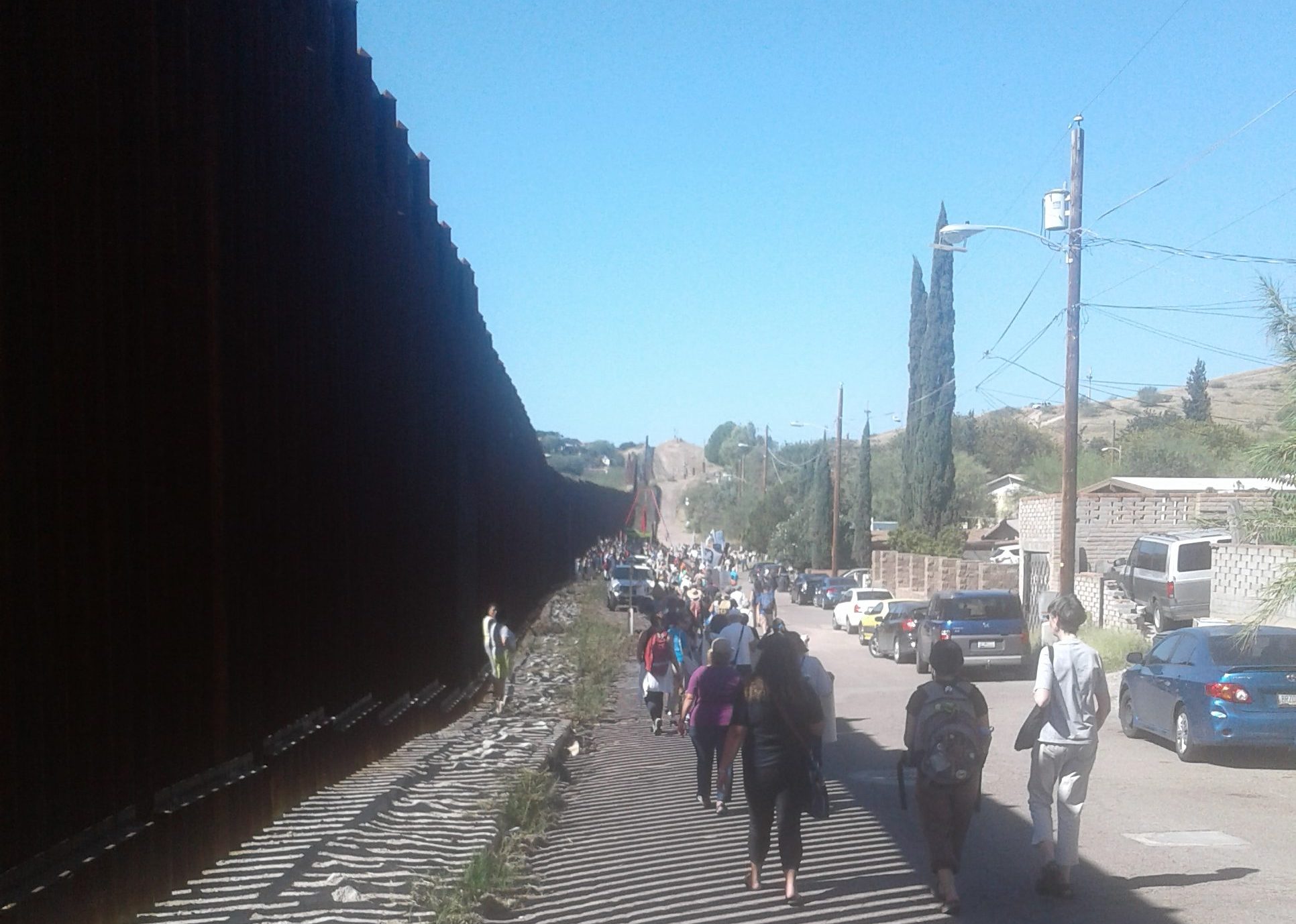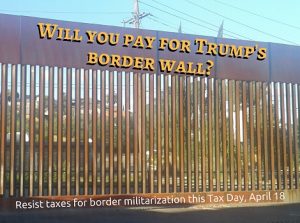
SOAW Border Convergence marchers approach the US/Mexico convergence stage, October 8, 2016.
October 2016: I’m crossing the border to Nogales, Arizona, US by foot, returning from a brief visit to Nogales in Sonora, Mexico, following the SOAW Border Convergence. A tall rusty steel border fence, maybe 20-25 feet tall, lines the border in both directions as far as I can see, dotted occasionally by even taller surveillance towers. While my entry to Mexico was a matter of walking in, I stand in a line for 45 minutes to re-enter the US. We’re waiting to present our passports, which are scanned and examined closely, get questioned by Border Patrol agents, and perhaps be sniffed by large Border Patrol dogs. I’m white and a US citizen, so I pass through easily, but I wonder about how easy it is for the Mexican citizens who travel between countries regularly to see friends and family, and to shop.
President Trump’s January 25, 2017 executive order to begin planning for a new US/Mexico border wall wasn’t a surprise to most people who were paying attention during the campaign. However, the extent of militarization at the southern border may surprise you—if you don’t live in a border state.
Although Trump sometimes portrays the borderlands as a lawless, wild region in need of control, over 670 miles of the 1,900-mile border between the US and Mexico are already walled or fenced off. The border is already patrolled by a heavily armed and armored Border Patrol. Thousands of undocumented immigrants end up in detention centers each year, and hundreds die in the desert each year trying to make it to a better life in the US.
The Bush Administration
After 9/11, the Bush administration created the Department of Homeland Security, growing the United States’ power to regulate immigration and travel. Immigrants from many majority-Muslim countries were forced to register their locations with the government, starting in 2002. (President Obama ended this practice in 2011 and formally ended the program at the end of 2016.)
The Secure Fence Act of 2006 was to fund 700+ miles of a double-fence border barrier, ostensibly to help prevent undocumented immigration. The built fence, however, was about 670 miles long, cost over $2.4 billion, and in many places (like Nogales) consisted of a single fence. Its primary function was to divert undocumented immigrants into the more dangerous open desert.
In addition, the government began to ramp up immigration enforcement within a 100-mile border zone sometimes called the “Constitution-free zone.” The Border Patrol budget increased sharply as a result (see the graph to the left). Border militarization was also increased through the Secure Communities program (active 2008-2014, and now revived by a Trump executive order). But thousands of people have died in the southern border area trying to make it to better lives in the US anyway.
Border security doesn’t just affect immigrants and travelers. The Tohono O’odham people have not been able to freely visit members of their own indigenous nation in Mexico for several years. The Tohono O’odham reservation in the US is occupied by Border Patrol checkpoints, surveillance towers, and armed Border Patrol agents who search for traveling undocumented immigrants and harass locals.
The Obama Administration
Many of the programs and trends begun during the Bush administration continued during Obama’s. Some immigrant rights activists have called President Obama the “deporter-in-chief,” because his administration had the largest number of formal removals of undocumented immigrants of any presidential administration, even as the number of people crossing the border was decreasing.
With the growth in concern about border security, the fiscal year (FY) budgets of US Customs and Border Protection (CBP, includes the Border Patrol) and Immigration and Customs Enforcement (ICE) have also grown:
| FY 2010 (enacted) | FY 2015 (enacted) | FY 2017 (requested) | |
| CBP | $11.5 billion | $11.8 billion | $13.9 billion |
| ICE | $5.7 billion | $5.8 billion | $6.2 billion |
In fact, in FY 2012, the budgets for CBP and ICE combined exceeded the collective budgets of all other federal law enforcement agencies (cited in Border Militarization Policy).
The Department of Homeland Security’s requested 2o17 budget for CBP included expenditures that illustrate border enforcement’s militarism:
- two King Air KA-350CER multi-role enforcement aircraft to patrol the Pacific coast
- funding for Integrated Fixed Towers to surveil the border zone (including Tohono O’odham land), made by Elbit Systems, which supplies the Israeli government’s surveillance towers along the wall separating Israel from the West Bank
- Black Hawk helicopters,
- M-4 rifles, and
- night sights for CBP P2000 pistols.
Although comprehensive immigration reform was an issue of much discussion during the terms of Presidents Bush and Obama, Congress was not able to pass a bill. Proposed comprehensive immigration reform bills included both a route to citizenship for some undocumented immigrants and increased border militarization.
The Trump Administration
President Trump is now calling for extending the border wall across the entire 1,900-mile length of the US/Mexico border. Recent estimates put the cost of such a wall at anywhere from $21.6 billion to as much as $40 billion. His administration consistently demonizes immigrants and refugees, portraying them as a danger to US residents. But many are fleeing wars, paramilitary violence, and poverty that are, in part, caused or facilitated by the United States (see for example: Syria, Iraq, Mexico, El Salvador, Guatemala, Nicaragua, and Honduras).
Take Action
 If you are unwilling to send your tax dollars to fund a border wall, border checkpoints within the US, Border Patrol occupation of indigenous land, and/or the war on immigrants and refugees, the National War Tax Resistance Coordinating Committee can provide knowledge and support:
If you are unwilling to send your tax dollars to fund a border wall, border checkpoints within the US, Border Patrol occupation of indigenous land, and/or the war on immigrants and refugees, the National War Tax Resistance Coordinating Committee can provide knowledge and support:
- Read more about border militarization tax resistance
- Read our informative materials in the Resist! and Resources sections
- Media: newsletter, blog, podcasts, interviews, and articles
- Learn about our programs, including Tax Day activities, gatherings, and more
- Contact the NWTRCC office, a war tax resistance counselor, or or a NWTRCC affiliate near you
- Buy war tax resistance literature and merchandise
Post by Erica
Updated with border militarization page link on 3/3/2017


the issue is not “wall or no (more) wall” BUT how are the COYOTE (drug/human trafficer) and their $6,000 (don’t get lost and die of dehydration) FEES going to be put out of business AND how are the EXPLOITERS of illegals (ALL OF US!) going to be THE FIRST 0- PRIORITY – TARGETS of enforcement! AN ELECTION OR TWO AGO A WOMAN “REPRESENTATIVE” (US HOUSE OF) herself had an ILLEGAL DOMESTIC – $8.00/hr. and NO BENEFITS OF COURSE! jmk klotzjm120@yahoo.com